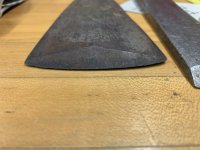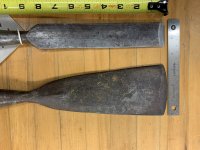Peter Rideout
Member
- Messages
- 1,668
- Location
- Nova Scotia, 45°N 64°W
Okay Guys, I need some serious help here.
A friend, who is a picker, showed up in my shop with these two treasures this morning. I had asked him 3-4 years ago to keep an eye out for a good old slick and framing chisels
He left them here to distract me and for me to find a fair price!! What are they worth as user tools in rural Nova Scotia, not the antique markets of affluent cities?
The slick appears to be hand forged with finer (harder?) steel at the tip. It looks like the back has been rounded off near the tipfrom improper sharpening, but it could be flattened with some hours of lapping. It seems to me it should be dead flat for proper paring cuts.
The chisel is from PS&W Co in Connecticut, a well-known tool maker from 1890 onward. Someone has hammered the sides of it a bit, but not to a shocking extent.
Lee Valley has a new similar size slick for about C$190. Shelter Institute timber framing school and store in Maine lists new slicks for close to C$300
Any help or direction you have would be much appreciated.

A friend, who is a picker, showed up in my shop with these two treasures this morning. I had asked him 3-4 years ago to keep an eye out for a good old slick and framing chisels
He left them here to distract me and for me to find a fair price!! What are they worth as user tools in rural Nova Scotia, not the antique markets of affluent cities?
The slick appears to be hand forged with finer (harder?) steel at the tip. It looks like the back has been rounded off near the tipfrom improper sharpening, but it could be flattened with some hours of lapping. It seems to me it should be dead flat for proper paring cuts.
The chisel is from PS&W Co in Connecticut, a well-known tool maker from 1890 onward. Someone has hammered the sides of it a bit, but not to a shocking extent.
Lee Valley has a new similar size slick for about C$190. Shelter Institute timber framing school and store in Maine lists new slicks for close to C$300
Any help or direction you have would be much appreciated.


